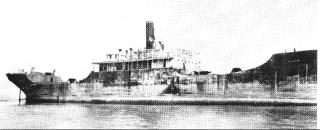pop up description layer
HOME
Cryptozoology UFO Mysteries Aviation Space & Time Dinosaurs Geology Archaeology Exploration 7 Wonders Surprising Science Troubled History Library Laboratory Attic Theater Store Index/Site Map Cyclorama
Search the Site: |
|
"Floating Tombstones"
As impossible as it seems, the ocean once carried a fleet of ships built mostly of concrete. Concrete, a mixture of sand and gravel bonded together with a cement to form a solid, heavy mass similar to stone, seems an unlikely substance to be used in ship construction. Wood, which floats, seems a better medium for building vessels and indeed was the preferred material for ship building for thousands of years. Steel became the standard material for large vessels by the end of the 19th century because it was very strong for its weight. During the first World War, though, steel was in short supply, yet ships had to be built. Ship builders took the idea a Norwegian inventor had patented a few years before in 1912 to use concrete instead of steel for the ship's hull. As strange as it seems, a ship of concrete will float as long as the weight of water it displaces is more than its own weight. It is a matter of density. The density of an object is the mass of an object divided by the volume. To float, the ship must be less dense than the same amount of water. A solid, cube of concrete (and for that matter steel) is more dense than the same cube of water and will sink like a stone. When the concrete is formed into the shape of a ship, though, with much of the interior empty air, the ship's total volume includes the air. Air is less dense than water. Since the total ship is a combination of air and concrete, the density for the whole ship becomes less than the water, allowing it to float. Should the ship spring a leak and fill with water forcing the air out, the density of the ship will become greater than that of the water, causing it to sink. In 1917 and 1918 British builders constructed barges, tugs and fishing boats using concrete. The Americans were more ambitious, commissioning a fleet of 12 ocean-going concrete freighters costing 50 million dollars. The concrete ships that were built followed the design of steel ships of that era, but required much thicker hulls to get the same amount of strength that the steel gave. A newly-developed form of concrete that included portland cement was used because it was relatively light (Only 120 pounds per cubic foot). Even so, the ships were much heavier than steel ships. The ship builders also found that concrete was much more difficult to manipulate than steel, making the ships more difficult to construct. The first of these ships finished was the Polias which was launched from the Liberty Company Shipyard of Wilmington, North Carolina in 1918. It was 250 feet long with a draft of 22 feet and a beam of 45 feet. The walls of the hull were six inches thick. She required only one-third of the steel necessary for a regular freighter. While these ships actually worked, many sailors referred to them as "floating tombstones" and did not like to serveron them. Still, some of them were used to transport troops back from Europe at the end of the first World War. Soon after the war when steel was more abundant, the concrete ships quickly became too expensive to operate. Their heavy hulls needed too much fuel to push them around and the ships became obsolete. One was turned into a casino, and another a restaurant. In 1926 what was to become the most famous of the fleet, the Atlantus, was bought to be used as part of a dock on a proposed ferry line to be run from Cape May, New Jersey, to Cape Henlopen, Delaware. While the ship was moored near the site awaiting its fate, a storm hit the region. The ship broke loose and grounded off of Sunset beach, Cape May. Stuck fast in the sand, all attempts to move it failed. The ruins of the vessel remain there even today and have been viewed by generations of visitors. It is a reminder about a time almost a century ago when concrete ships plied the seas. Copyright Lee Krystek 1999. All Rights Reserved. For a Danish translation of this page: http://sciencelakes.com/flydende-gravstene/ For a Polish translation of this page: http://www.bildelerstore.co.no/teaching/2016/06/04/plywajace-nagrobki/ For a Indonesian translation of this page: https://www.chameleonjohn.com/translations/concrete-Indonesian For a Macedonian translation of this page: https://equipmyfinance.com/translations/floating-tombstones-macedonian/ For a Portuguese language translation of this page: http://www.travel-ticker.com/translations/concrete
|
|
Related Links |
|
|




